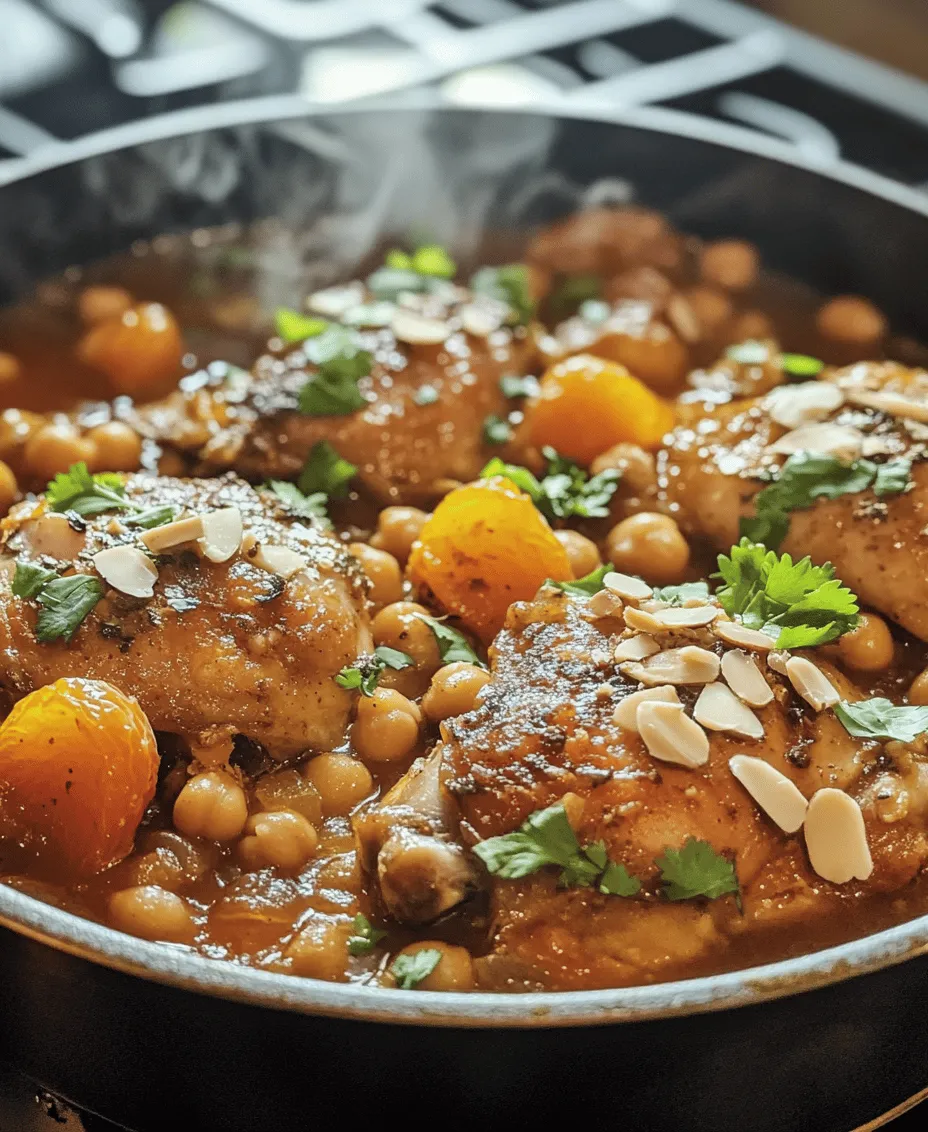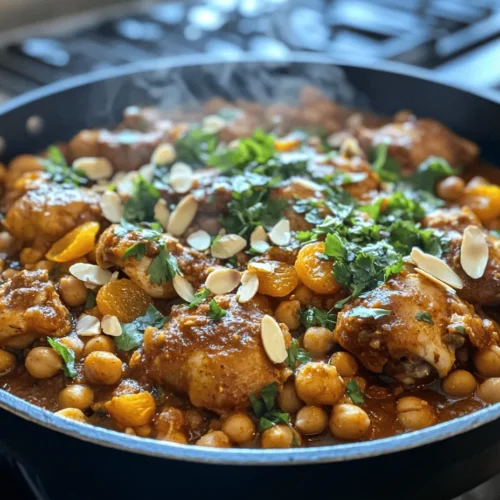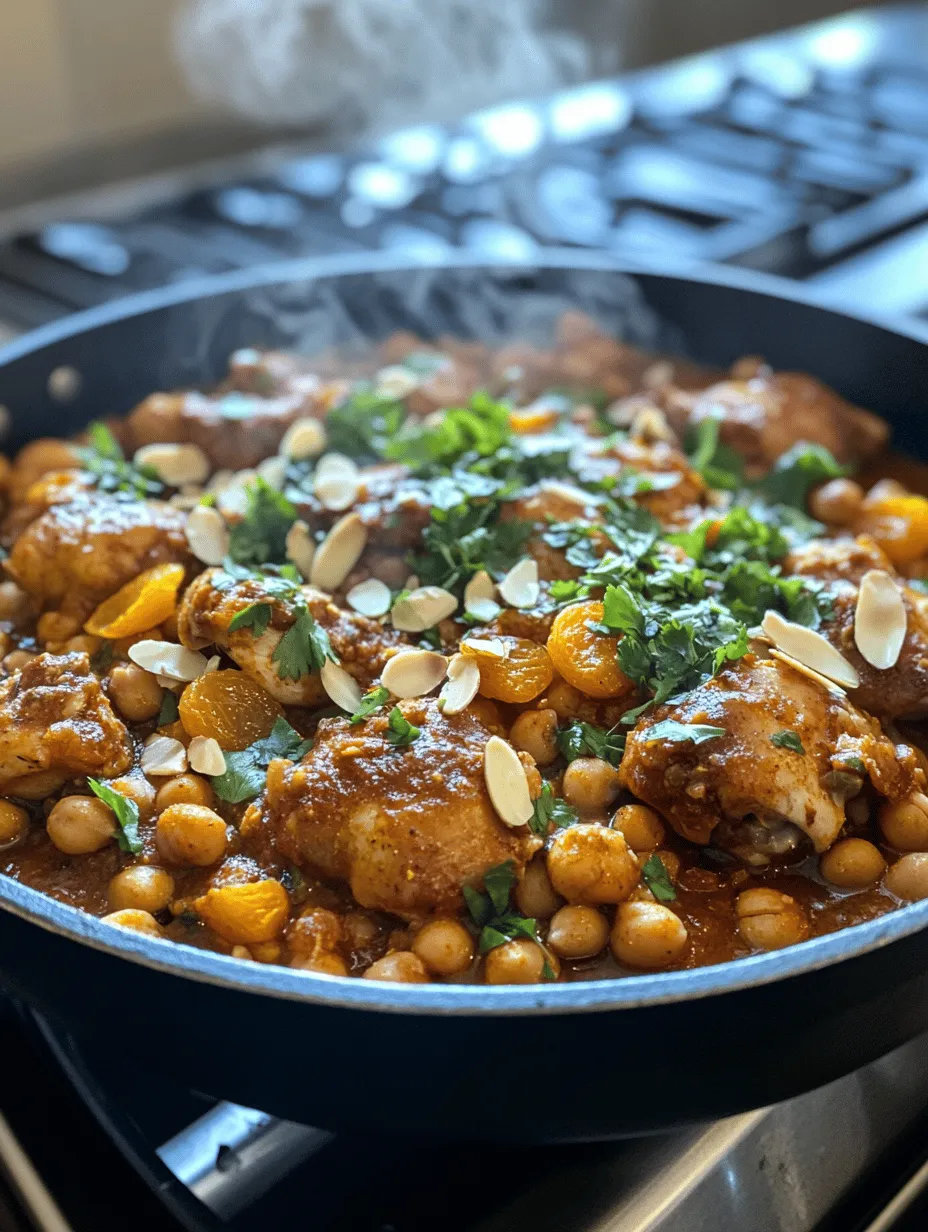Introduction
Explore the vibrant flavors of North Africa with Moroccan Spiced Chicken, a dish that brings a delightful blend of spices and textures to your table. This aromatic recipe features tender chicken thighs marinated in a symphony of spices, complemented by hearty chickpeas and sweet apricots. Perfect for a family dinner or a gathering with friends, this dish not only tantalizes the taste buds but also offers a glimpse into the rich culinary traditions of Morocco.
Moroccan cuisine is renowned for its bold flavors, fragrant spices, and the ability to transform simple ingredients into something extraordinary. The juxtaposition of sweet and savory, along with the use of fresh herbs and spices, creates a dining experience that is both exciting and satisfying. Moroccan Spiced Chicken embodies this spirit, making it a beloved dish in homes and restaurants worldwide.
This recipe invites you to embark on a culinary adventure, where each bite transports you to the bustling markets of Marrakech or the serene landscapes of the Atlas Mountains. The combination of juicy chicken thighs, earthy chickpeas, and succulent dried apricots creates a delightful harmony of flavors, while the carefully curated spice blend elevates the dish, ensuring it’s anything but ordinary.
Understanding Moroccan Cuisine
Delve into the essence of Moroccan cooking, characterized by its diverse ingredients and intricate spice blends. Moroccan cuisine is a melting pot of various influences, including Berber, Arab, and Mediterranean traditions. The use of spices is a cornerstone of this culinary style, with each ingredient playing a vital role in bringing depth and character to the dishes.
Spices such as cumin, coriander, and cinnamon are staples in Moroccan kitchens, contributing to the complex flavor profiles that define the cuisine. Cumin, with its earthy and warm notes, is often used in marinades and stews, enhancing the natural flavors of the ingredients. Coriander, with its citrus undertones, adds brightness and freshness, while cinnamon introduces a hint of sweetness and warmth, often found in both savory and sweet dishes.
In addition to spices, Moroccan cuisine makes extensive use of fruits and legumes. Dried fruits like apricots and raisins are commonly incorporated into savory dishes, providing a delightful contrast to the spices and proteins. Legumes, such as chickpeas, are not only a source of protein but also add a hearty texture to meals. Together, these elements create a balanced and nutritious dining experience that reflects the vibrant culture of Morocco.
Ingredients Breakdown
The Star of the Dish: Chicken Thighs
When it comes to making Moroccan Spiced Chicken, the choice of chicken is paramount. For this recipe, we recommend using bone-in, skin-on chicken thighs. This cut of meat is favored for its rich flavor and tender texture, making it ideal for slow cooking and marinating. The bones provide additional moisture and depth to the dish, ensuring that the chicken remains juicy and succulent throughout the cooking process.
Chicken thighs are not only delicious but also more forgiving than chicken breasts when it comes to cooking times. They are less likely to dry out, allowing for a higher degree of flexibility during the cooking process. This makes them an excellent choice for busy home cooks who want to prepare a flavorful meal without the stress of precise timing.
The Aromatics: Onion, Garlic, and Ginger
The foundation of any great dish lies in its aromatics, and Moroccan Spiced Chicken is no exception. Onions, garlic, and ginger form the aromatic trio that enhances the dish’s depth of flavor.
Onions, when sautéed, develop a natural sweetness that balances the spices, while garlic adds an unmistakable savory note, infusing the dish with warmth and character. Fresh ginger, with its zesty kick, introduces a layer of brightness that complements the other flavors beautifully. Together, these ingredients create a fragrant base that elevates the overall taste of the dish, making it truly memorable.
The Spice Profile
The magic of Moroccan Spiced Chicken lies in its meticulously crafted spice blend, which gives the dish its distinctive character. Here’s a detailed look at each spice used in the recipe:
– Cumin: Known for its earthy and warm flavor, cumin is a cornerstone of Moroccan cuisine. It adds depth and richness, enhancing the umami of the chicken and other ingredients. Cumin is often praised for its health benefits, including aiding digestion and boosting the immune system.
– Coriander: With its subtle citrus undertones, coriander brightens the dish and adds a refreshing note. Ground coriander seeds bring a unique flavor that pairs beautifully with cumin, creating a harmonious blend that is both fragrant and flavorful.
– Cinnamon: While often associated with sweet dishes, cinnamon plays a crucial role in Moroccan savory recipes. Its warm sweetness adds complexity to the spice mix, balancing the heat and earthiness of the other spices. Cinnamon is also known for its anti-inflammatory properties and ability to regulate blood sugar levels.
– Turmeric: This vibrant yellow spice not only adds color but also brings a mild, earthy flavor along with numerous health benefits. Turmeric is rich in antioxidants and has anti-inflammatory properties, making it a valuable addition to any dish.
– Smoked Paprika: For a touch of smoky depth, smoked paprika is a must. It enhances the flavor profile of the chicken, contributing to a warm and inviting aroma. This spice adds a subtle layer of richness that elevates the overall experience of the dish.
– Cayenne Pepper: Adjusting the heat levels is important in Moroccan cooking, and cayenne pepper allows you to customize the spice level to your preference. Just a pinch can add a delightful kick, while leaving it out will keep the dish mild and approachable.
Additional Ingredients
In addition to the chicken and spices, several other ingredients play vital roles in creating a balanced dish.
– Chicken Broth: The foundation of any stew-like dish, chicken broth adds moisture and flavor. It creates a rich and savory base that helps the spices and aromatics meld together beautifully.
– Chickpeas: These versatile legumes provide a hearty texture and a substantial source of protein. Chickpeas absorb the flavors of the spices and broth, making them a perfect complement to the chicken. They also add a delightful creaminess to the dish.
– Dried Apricots: The inclusion of sweet dried apricots adds a surprising twist to the dish. Their natural sweetness contrasts with the spices, creating a delightful balance that is characteristic of Moroccan cuisine. They also contribute essential vitamins and minerals, such as vitamin A and potassium.
– Lemon Juice: A splash of fresh lemon juice brightens the dish, cutting through the richness of the chicken and enhancing the overall flavor. The acidity of the lemon helps to elevate the spices, providing a refreshing finish to each bite.
Step-by-Step Preparation
Now that we have a comprehensive understanding of the ingredients and their roles in Moroccan Spiced Chicken, it’s time to dive into the step-by-step preparation. The following instructions will guide you through the process of creating this aromatic dish, ensuring that you achieve the perfect balance of flavors and textures.
1. Marinating the Chicken: Begin by preparing the marinade for the chicken. In a large bowl, combine the ground spices—cumin, coriander, cinnamon, turmeric, smoked paprika, and cayenne pepper—with minced garlic, grated ginger, and a pinch of salt. Add a drizzle of olive oil and the juice of half a lemon to create a paste-like consistency. Toss the chicken thighs in the marinade, ensuring they are evenly coated. Cover the bowl and let it marinate in the refrigerator for at least 1 hour, or ideally overnight for maximum flavor infusion.
2. Sautéing the Aromatics: In a large, heavy-bottomed pot or Dutch oven, heat a tablespoon of olive oil over medium heat. Add finely chopped onions and sauté until they become translucent and fragrant, about 5-7 minutes. Stir in minced garlic and grated ginger, cooking for an additional minute until aromatic.
3. Browning the Chicken: Once the aromatics are ready, remove the marinated chicken thighs from the refrigerator. Increase the heat to medium-high and add the chicken thighs to the pot, skin side down. Sear the chicken for about 4-5 minutes, allowing the skin to brown and crisp up. Flip the chicken and sear the other side for another 3-4 minutes. This step is crucial for developing a rich flavor and a beautiful golden color.
4. Building the Stew: After browning the chicken, add the chickpeas and dried apricots to the pot, stirring to combine. Pour in the chicken broth, ensuring that the ingredients are submerged. Bring the mixture to a gentle simmer, then reduce the heat to low. Cover the pot and let it cook for about 30-40 minutes, or until the chicken is tender and fully cooked through.
5. Finishing Touches: Once the chicken is cooked, taste the sauce and adjust the seasoning as needed. A splash of fresh lemon juice can be added at this stage to brighten the flavors further. Serve the Moroccan Spiced Chicken warm, garnished with fresh herbs like cilantro or parsley for an added touch of freshness.
This step-by-step preparation not only ensures that you achieve a perfect result but also allows you to appreciate the intricate flavors that come together in this delightful dish. Stay tuned for the next parts of the article, where we’ll explore tips for the best results and answer some common questions about Moroccan Spiced Chicken.

Marinating the Chicken
Marinating the chicken is a crucial step in preparing Moroccan Spiced Chicken, as it infuses the meat with rich flavors that are characteristic of Moroccan cuisine. Begin with boneless, skinless chicken thighs or breasts, as these cuts tend to absorb marinades better due to their higher fat content.
To create the marinade, combine olive oil, minced garlic, ground cumin, coriander, paprika, cinnamon, turmeric, and a pinch of cayenne pepper in a mixing bowl. The olive oil not only adds richness but also helps the spices adhere to the chicken. Additionally, squeeze in fresh lemon juice for acidity, which helps to tenderize the meat and brighten the overall flavor profile.
Once mixed, coat the chicken thoroughly with the marinade, ensuring every piece is well-covered. For the best results, allow the chicken to marinate for at least 1 hour, though overnight marination in the refrigerator is ideal. This extended time allows the spices to penetrate the meat deeply, creating a succulent and flavorful dish.
Sautéing the Aromatics
As the chicken marinates, focus on preparing the aromatics that will lay the foundation for the dish. Start by heating a generous amount of olive oil in a large Dutch oven or heavy-bottomed skillet over medium heat. Once the oil is shimmering, add finely chopped onions.
Sauté the onions slowly, stirring occasionally until they turn translucent and begin to caramelize, which usually takes about 8-10 minutes. This step is essential, as caramelizing the onions develops their natural sweetness and adds complexity to the dish. As the onions cook, you can also add minced ginger and garlic, allowing them to sauté for an additional minute. This combination creates a fragrant base that enhances the overall flavor of the Moroccan Spiced Chicken.
Browning the Chicken
Once the onions are perfectly sautéed, it’s time to add the marinated chicken to the pot. Allow the excess marinade to drip off before placing the chicken in the hot oil. Avoid overcrowding the pan; instead, work in batches if necessary. Browning the chicken is critical for flavor development. The Maillard reaction—where proteins and sugars react under heat—creates a rich, golden-brown crust on the chicken, enhancing its taste and aroma.
Cook the chicken for about 4-5 minutes on each side, or until it achieves a deep golden color. This step not only elevates the flavor of the chicken but also contributes to the overall depth of the dish when combined with the sautéed onions.
Combining Ingredients
After browning the chicken, it’s essential to layer the flavors effectively. Remove the chicken from the pot and set it aside temporarily. In the same pot, add diced tomatoes (canned or fresh) and stir well, scraping up the browned bits at the bottom of the pan. These bits are packed with flavor and will enrich the sauce.
Next, return the chicken to the pot and add chickpeas (canned or cooked), dried apricots or raisins, and a handful of olives, if desired. Each of these ingredients plays a pivotal role in the dish, contributing sweetness, saltiness, and texture. Carefully combine everything to ensure the chicken is surrounded by the other ingredients, allowing the flavors to meld beautifully.
Simmering for Flavor Development
With the chicken and other ingredients now combined, it’s time to introduce the broth. Pour in chicken or vegetable broth until it covers the chicken about halfway. Bring the mixture to a gentle simmer, then reduce the heat to low, cover the pot, and let it cook for 30-40 minutes.
Simmering allows the spices to infuse the chicken and chickpeas while thickening the sauce. This slow cooking method ensures that the chicken remains tender and moist. You can check for seasoning during the last few minutes of cooking, adjusting with salt, pepper, or additional spices as needed. The final result should be a fragrant, cohesive dish that is hearty and comforting.
Serving Suggestions
Once the Moroccan Spiced Chicken is finished cooking, it’s time to serve. This dish pairs beautifully with fluffy couscous, which absorbs the aromatic sauce and complements the spices. Alternatively, serve it over rice or alongside warm, crusty bread for a complete meal.
For a vibrant presentation, garnish the dish with freshly chopped cilantro or parsley and a sprinkle of toasted almonds or sesame seeds. The added crunch and brightness from the herbs enhance the dish’s visual appeal and flavor profile. To elevate the experience further, consider serving a side of tangy yogurt or a fresh salad with citrus and herb dressing to balance the spices.
Nutritional Value of Moroccan Spiced Chicken
Moroccan Spiced Chicken is not only delicious but also packed with nutritional benefits. Chicken is an excellent source of lean protein, which is essential for muscle growth and repair. The addition of chickpeas contributes dietary fiber, which aids in digestion and helps maintain stable blood sugar levels.
Spices such as turmeric and cumin are known for their anti-inflammatory properties and health benefits. Additionally, the use of olive oil provides heart-healthy fats. This dish is a wonderful example of how traditional ingredients can come together to create a meal that is both nutritious and satisfying.
Variations and Customizations
One of the joys of cooking is the ability to customize recipes to suit your tastes. For Moroccan Spiced Chicken, consider these variations:
– Different Cuts of Chicken: While thighs are recommended for their richness, chicken breasts or drumsticks can also be used. Just adjust cooking times accordingly to ensure the chicken remains tender and juicy.
– Adding Vegetables: Incorporate seasonal vegetables such as bell peppers, zucchini, or carrots for added nutrition and color. Simply sauté them with the onions, or add them to the pot before simmering.
– Experimenting with Dried Fruits: While dried apricots and raisins are traditional, feel free to use figs or prunes for a different flavor profile. Each fruit brings its own sweetness and texture to the dish.
– Spice Level: Adjust the amount of cayenne pepper depending on your spice tolerance. You could also add fresh chilis for an extra kick.
These variations allow you to make this Moroccan Spiced Chicken your own while introducing new flavors and textures.
Conclusion
Moroccan Spiced Chicken is a culinary journey that transports you to the heart of Morocco with each flavorful bite. This dish, rich in spices and bursting with textures, is perfect for family gatherings or a cozy dinner at home. By mastering this recipe, you not only expand your culinary repertoire but also gain a deeper appreciation for the rich tapestry of flavors that define Moroccan cuisine.
As you savor the tantalizing blend of spices and the succulent chicken, let this dish inspire your future culinary adventures. Gather your loved ones, set the table, and enjoy the warmth and richness of Moroccan Spiced Chicken—an experience that delights and nourishes both body and soul.


